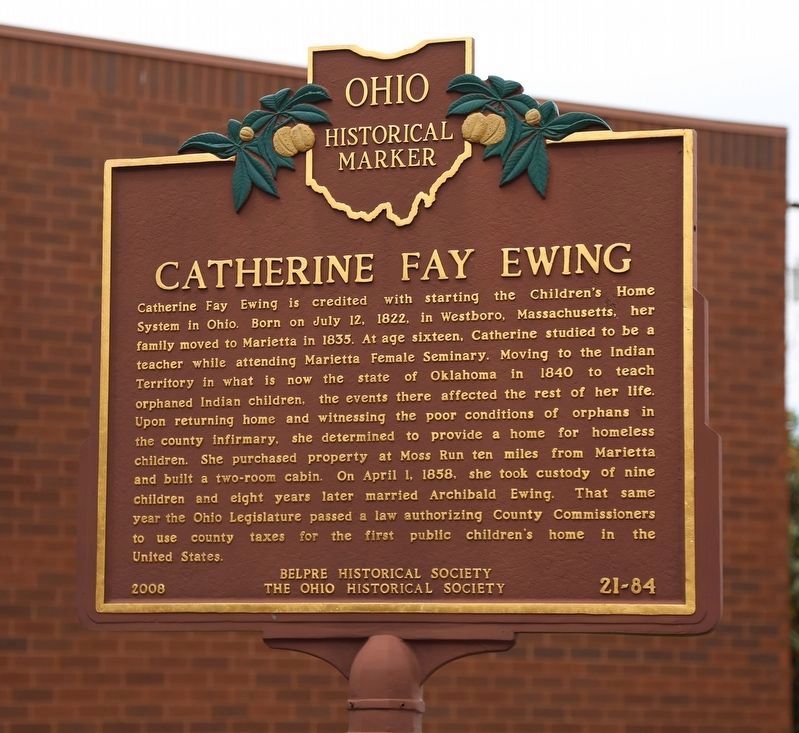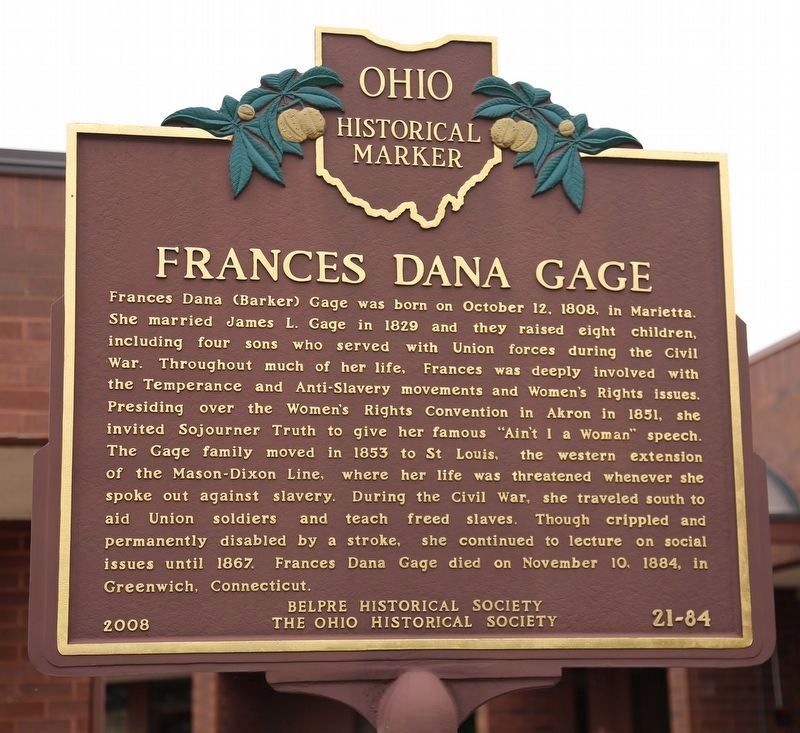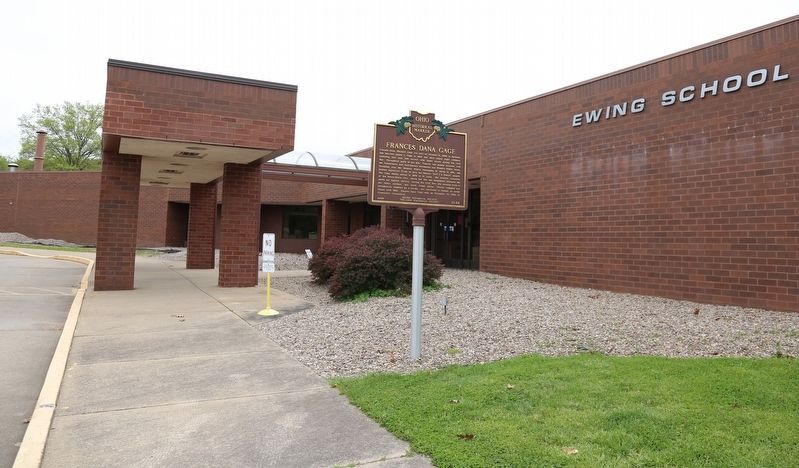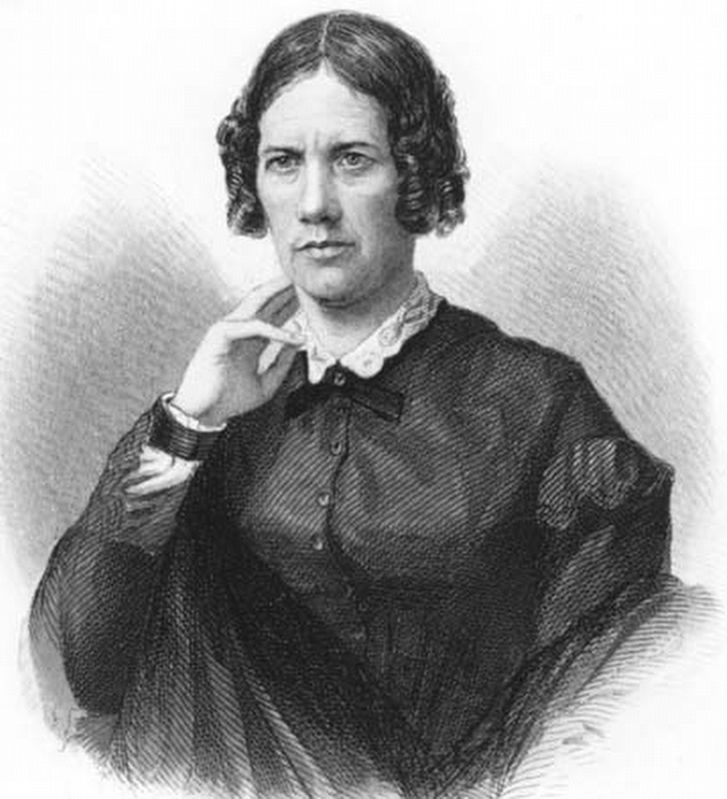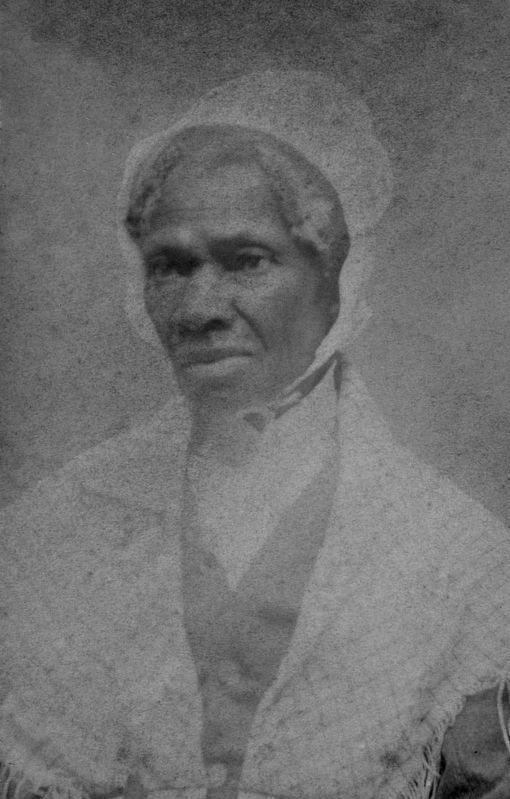Marietta in Washington County, Ohio — The American Midwest (Great Lakes)
Catherine Fay Ewing / Frances Dana Gage
Frances Dana Gage. Frances Dana (Barker) Gage was born on October 12, 1808, in Marietta. She married James L. Gage in 1829 and they raised eight children, including four sons who served with Union forces during the Civil War. Throughout much of her life, Frances was deeply involved with the Temperance and Anti-Slavery movements and Women’s Rights issues. Presiding over the Women’s Rights Convention in Akron in 1851, she invited Sojourner Truth to give her famous “Ain’t I a Woman” speech. The Gage family moved in 1853 to St Louis, the western extension of the Mason-Dixon Line, where her life was threatened whenever she spoke out against slavery. During the Civil War, she traveled south to aid Union soldiers and teach freed slaves. Though crippled and permanently disabled by a stroke, she continued to lecture on social issues until 1867. Frances Dana Gage died on November 10, 1884, in Greenwich, Connecticut.
Erected 2008 by Belpre Historical Society and the Ohio Historical Society. (Marker Number 21-84.)
Topics and series. This historical marker is listed in these topic lists: Abolition & Underground RR • Charity & Public Work • Civil Rights • Education. In addition, it is included in the Ohio Historical Society / The Ohio History Connection series list. A significant historical year for this entry is 1858.
Location. 39° 26.556′ N, 81° 27.521′ W. Marker is in Marietta, Ohio, in Washington County. Marker is on Colegate Drive just east of Muskingum Drive (Ohio Route 60), on the right when traveling east. It is at the entrance to Ewing School. Touch for map. Marker is in this post office area: Marietta OH 45750, United States of America. Touch for directions.
Other nearby markers. At least 8 other markers are within 2 miles of this marker, measured as the crow flies. Children’s Home (about 400 feet away, measured in a direct line); Sewah Studios (approx. ¾ mile away); William Pitt Richardson (approx. 1.4 miles away); Sacra Via (approx. 1.4 miles away); The Northwest Ordinance, 1787 / The Ohio Company Purchase (approx. 1.4 miles away); Campus Martius (approx. 1½ miles away); The American Union Lodge No. 1 Free and Accepted Masons (approx. 1½ miles away); Rufus Dawes House (approx. 1½ miles away). Touch for a list and map of all markers in Marietta.
Related markers. Click here for a list of markers that are related to this marker.
Also see . . .
1. Catherine Fay Ewing. Article by Henry Robert Burke. “Catherine stated that in the fall of 1853, while laboring as a missionary among the Choctaw Indians, a physician called upon her and asked her to visit a poor family where the mother, a New England woman of culture and refinement, had died leaving five small children. Their drunken father had deserted them and the physician wished for Catherine Fay to adopt a beautiful little girl who was two years old. Catherine very much wanted to adopt the little girl but she was but a poor teacher hundreds of miles from home, and it seemed impracticable. Subsequently the little girl was taken in by a man and his wife who sold
whisky to the Indians. One day there was a drunken fight, and the child was thrown down the steps of the house and killed. This tragedy affected Catherine Fay so deeply that she determined to secure a home of her own where she could care for homeless children. From that time every dollar she could possibly spare was laid away and directed toward that purpose.” (Submitted on May 24, 2017.)
2. Wikipedia Entry for Catherine Amelia Fay Ewing. “The first few weeks were very hard ones, the trustees of the district school refusing to allow the children to attend school because they were paupers, and they were unwilling to have their own children associate with them. After a lawsuit, she obtained permission to send them to school, but the children were taunted as poorhouse children. A few months later, before the ensuing winter, she moved into the new home with 20 rooms, and the first children’s home was an accomplished fact. Its cost was $2000, and in five years, $4000 had been expended on the property. She also built her own school house and engaged a teacher.” (Submitted on May 24, 2017.)
3. Wikipedia Entry for Frances Dana Gage. “Gage wrote that her woman suffrage work began when she was ten years old, in 1818. She helped her father make barrels and her work was so well executed that her father
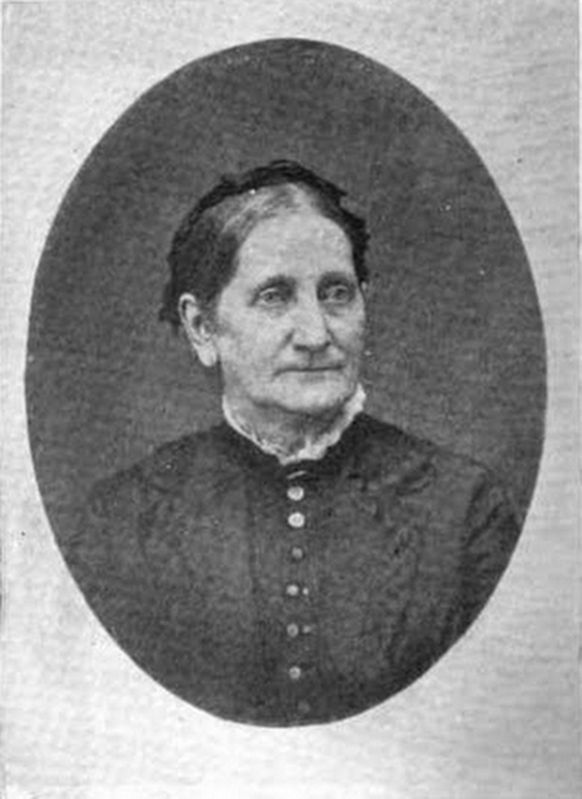
Via Wikipedia Commons
4. Catherine Amelia Fay Ewing (1822-1897), educator, philanthropist, activist, and social reformer
From the 1897 book American Women: Fifteen Hundred Biographies with Over 1,400 Portraits : a Comprehensive Encyclopedia of the Lives and Achievements of American Women During the Nineteenth Century published by Mast, Crowell & Kirkpatrick.
“Though Gage was inspired at an early age, she did begin her activist work until after 1848. In 1850, she held a convention in McConnelsville, Ohio, which seventy people attended. Those at the convention fought to have race and gender removed from requirements for state citizenship and voting rights in the Ohio Constitution. Their work was not successful.” (Submitted on May 24, 2017.)
4. Wikipedia entry for Sojourner Truth. “In 1851, Truth joined George Thompson, an abolitionist and speaker, on a lecture tour through central and western New York State. In May, she attended the Ohio Women’s Rights Convention in Akron, Ohio, where she delivered her famous extemporaneous speech on women's rights, later known as ‘Ain’t I a Woman.’ Her speech demanded equal human rights for all women as well as for all blacks. The convention was organized by Hannah Tracy and Frances Dana Barker Gage, who both were present when Truth spoke. Different versions of Truth’s words have been recorded, with the first one published a month later in the Anti-Slavery Bugle by Rev. Marius Robinson,
the newspaper owner and editor who was in the audience. Robinson's recounting of the speech included no instance of the question ‘Ain’t I a Woman?’” (Submitted on May 24, 2017.)
5. Wikipedia Entry for “Ain't I a Woman?”. 1851 version by Maurius Robinson in the Anti-Slavery Bugle. “One of the most unique and interesting speeches of the convention was made by Sojourner Truth, an emancipated slave. It is impossible to transfer it to paper, or convey any adequate idea of the effect it produced upon the audience. Those only can appreciate it who saw her powerful form, her whole-souled, earnest gesture, and listened to her strong and truthful tones. She came forward to the platform and addressing the President said with great simplicity: ‘May I say a few words?’ Receiving an affirmative answer, she proceeded:
“ ‘I want to say a few words about this matter. I am a Women’s Rights. I have as much muscle as any man, and can do as much work as any man. I have plowed and reaped and husked and chopped and mowed, and can any man do more than that? I have heard much about the sexes being equal. I can carry as much as any man, and can eat as much too, if I can get it. I am as strong as any man that is now. As for intellect, all I can say is, if a woman have a pint, and a man a quart – why can’t she have her little pint full? You need not be
afraid to give us our rights for fear we will take too much, – for we can't take more than our pint’ll hold. The poor men seems to be all in confusion, and don’t know what to do. Why children, if you have Women's Rights [to give], give it to her and you will feel better. You will have your own rights, and they won’t be so much trouble. I can’t read, but I can hear. I have heard the bible and have learned that Eve caused man to sin. Well, if woman upset the world, do give her a chance to set it right side up again. The Lady has spoken about Jesus, how he never spurned woman from him, and she was right. When Lazarus died, Mary and Martha came to him with faith and love and besought him to raise their brother. And Jesus wept and Lazarus came forth. And how came Jesus into the world? Through God who created him and the woman who bore him. Man, where was your part? But the women are coming up, blessed be God, and a few of the men are coming up with them. But man is in a tight place, the poor slave is on him, woman is coming on him, he is surely between a hawk and a buzzard.’” (Submitted on May 24, 2017.)
6. Kerry Washington reads the 1863 Frances Dana Gage version of “Ain’t I a Woman?” in 2016.
(Submitted on May 24, 2017.)
Credits. This page was last revised on May 17, 2018. It was originally submitted on May 24, 2017, by J. J. Prats of Powell, Ohio. This page has been viewed 759 times since then and 38 times this year. It was the Marker of the Week May 28, 2017. Photos: 1, 2, 3, 4, 5, 6. submitted on May 24, 2017, by J. J. Prats of Powell, Ohio. 7. submitted on May 25, 2017, by J. J. Prats of Powell, Ohio.
